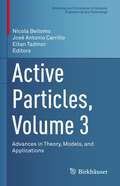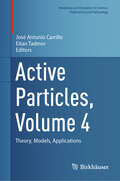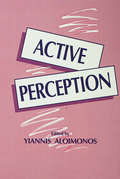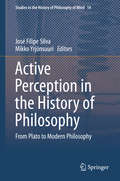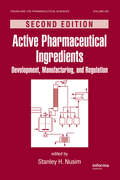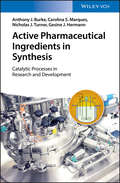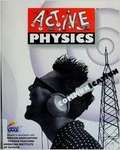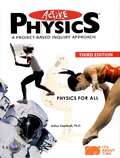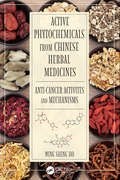- Table View
- List View
Active Particles, Volume 3: Advances in Theory, Models, and Applications (Modeling and Simulation in Science, Engineering and Technology)
by Nicola Bellomo José Antonio Carrillo Eitan TadmorThis edited volume collects six surveys that present state-of-the-art results on modeling, qualitative analysis, and simulation of active matter, focusing on specific applications in the natural sciences. Following the previously published Active Particles volumes, these chapters are written by leading experts in the field and reflect the diversity of subject matter in theory and applications within an interdisciplinary framework. Topics covered include:Variability and heterogeneity in natural swarmsMultiscale aspects of the dynamics of human crowdsMathematical modeling of cell collective motion triggered by self-generated gradientsClustering dynamics on graphsRandom Batch Methods for classical and quantum interacting particle systemsThe consensus-based global optimization algorithm and its recent variantsMathematicians and other members of the scientific community interested in active matter and its many applications will find this volume to be a timely, authoritative, and valuable resource.
Active Particles, Volume 4: Theory, Models, Applications (Modeling and Simulation in Science, Engineering and Technology)
by José Antonio Carrillo Eitan TadmorThis edited volume collects nine surveys that present the state-of-the-art in modeling, qualitative analysis, and simulation of active particles, focusing on specific applications in the natural sciences. As in the preceding Active Particles volumes, it blends diverse applications that demonstrate the interdisciplinary nature of the subject and the various mathematical tools available. Contributions were selected with the aim of covering a variety of viewpoints, from modeling the interactions in collective dynamics of animals and in population dynamics; through neural-networks, semi-supervised learning, and Monte Carlo methods in optimization; to kinetic and continuum theories with applications to aggregations and birth-and-death processes. Mathematicians and other members of the scientific community interested in active matter and its many applications will find this volume to be a timely, authoritative, and valuable resource.
Active Perception (Computer Vision Series)
by Yiannis AloimonosThis book defines the emerging field of Active Perception which calls for studying perception coupled with action. It is devoted to technical problems related to the design and analysis of intelligent systems possessing perception such as the existing biological organisms and the "seeing" machines of the future. Since the appearance of the first technical results on active vision, researchers began to realize that perception -- and intelligence in general -- is not transcendental and disembodied. It is becoming clear that in the effort to build intelligent visual systems, consideration must be given to the fact that perception is intimately related to the physiology of the perceiver and the tasks that it performs. This viewpoint -- known as Purposive, Qualitative, or Animate Vision -- is the natural evolution of the principles of Active Vision. The seven chapters in this volume present various aspects of active perception, ranging from general principles and methodological matters to technical issues related to navigation, manipulation, recognition, learning, planning, reasoning, and topics related to the neurophysiology of intelligent systems.
Active Perception in the History of Philosophy: From Plato to Modern Philosophy (Studies in the History of Philosophy of Mind #14)
by José Filipe Silva Mikko YrjönsuuriThe aim of the present work is to show the roots of the conception of perception as an active process, tracing the history of its development from Plato to modern philosophy. The contributors inquire into what activity is taken to mean in different theories, challenging traditional historical accounts of perception that stress the passivity of percipients in coming to know the external world. Special attention is paid to the psychological and physiological mechanisms of perception, rational and non-rational perception and the role of awareness in the perceptual process. Perception has often been conceived as a process in which the passive aspects - such as the reception of sensory stimuli - were stressed and the active ones overlooked. However, during recent decades research in cognitive science and philosophy of mind has emphasized the activity of the subject in the process of sense perception, often associating this activity to the notions of attention and intentionality. Although it is recognized that there are ancient roots to the view that perception is fundamentally active, the history remains largely unexplored. The book is directed to all those interested in contemporary debates in the fields of philosophy of mind and cognitive psychology who would like to become acquainted with the historical background of active perception, but for historical reliability the aim is to make no compromises.
Active Pharmaceutical Ingredients: Development, Manufacturing, and Regulation, Second Edition (ISSN)
by Stanley H. NusimTo successfully bring an Active Pharmaceutical Ingredient (API) to market, many steps must be followed to ensure compliance with governmental regulations. This book is an unparalleled guide to the development, manufacturing, and regulation of the preparation and use of APIs globally. This secoond edition brings readers up-to-date with the quality control regulations for APIs that have been added or amended since the first edition. These updates help ensure that pharmaceutical professionals and drug manufacturers meet the established and required guidelines set forth by the US and international regulatory industries.
Active Pharmaceutical Ingredients in Synthesis: Catalytic Processes in Research and Development
by Gesine J. Hermann Nicholas J. Turner Carolina Silva Marques Anthony J. BurkePresents the most effective catalytic reactions in use today, with a special focus on process intensification, sustainability, waste reduction, and innovative methods This book demonstrates the importance of efficient catalytic transformations for producing pharmaceutically active molecules. It presents the key catalytic reactions and the most efficient catalytic processes, including their significant advantages over compared previous methods. It also places a strong emphasis on asymmetric catalytic reactions, process intensification (PI), sustainability and waste mitigation, continuous manufacturing processes as enshrined by continuous flow catalysis, and supported catalysis. Active Pharmaceutical Ingredients in Synthesis: Catalytic Processes in Research and Development offers chapters covering: Catalysis and Prerequisites for the Modern Pharmaceutial Industry Landscape; Catalytic Process Design - The Industrial Perspective; Hydrogenation, Hydroformylation and Other Reductions; Oxidation; ; Catalytic Addition Reactions; Catalytic Cross-Coupling Reactions; Catalytic Metathesis Reactions; Catalytic Cycloaddition Reactions: Coming Full-Circle; Catalytic Cyclopropanation Reactions; Catalytic C-H insertion Reactions; Phase Transfer Catalysis; and Biocatalysis. -Provides the reader with an updated clear view of the current state of the challenging field of catalysis for API production -Focuses on the application of catalytic methods for the synthesis of known APIs -Presents every key reaction, including Diels-Alder, CH Insertions, Metal-catalytic coupling-reactions, and many more -Includes recent patent literature for completeness Covering a topic of great interest for synthetic chemists and R&D researchers in the pharmaceutical industry, Active Pharmaceutical Ingredients in Synthesis: Catalytic Processes in Research and Development is a must-read for every synthetic chemist working with APIs.
Active Physical Science (Student Edition)
by Arthur Eisenkraft Gary FreeburyBook contains two units, Active Physics and Active Chemistry.
Active Physics: An Inquiry Approach to Physics
by Arthur EisenkrafPhysics should be experienced and make sense to you. Each chapter of Active Physics begins with a challenge--develop a sport that can be played on the Moon; build a home for people with a housing crisis; persuade your parents to lend you the family car; and so on. These are tough challenges, but you will learn the physics that will allow you to be successful at every one. Part of your education is to learn to trust yourself and to question others. When someone tells you something, can they answer your questions: "How do you know? Why should I believe you? and Why should I care?" After Active Physics, when you describe why seat belts are important, or why sports can be played on the moon, or why communication with extraterrestrials is difficult, and someone asks, "How do you know?" your answer will be, "I know because I did an experiment."
Active Physics: Medicine
by Arthur EisenkraftDr. Arthur Eisenkraft, project director, presents a short overview explaining how and why Active physics works. High School Physics Textbook.
Active Physics: Medicine
by Arthur EisenkraftDr. Arthur Eisenkraft, project director, presents a short overview explaining how and why Active physics works. High School Physics Textbook.
Active Physics - A Project Based Inquiry Approach
by Arthur EisenkraftActive Physics is based on research in the cognitive sciences- the research on how students learn-encapsulated in the 7E Instructional Model (Elicit, Engage, Explore, Explain, Elaborate, Evaluate, Extend). As a result, Active Physics provides ALL students with a deep and memorable learning experience. Cover topics like Driving the Roads, Electricity, Music and Sound, Sports and Thrills and Chills.
Active Physics Sports
by Arthur Eisenkraft Howard Brody Mary Quinlan Carl Duzen David Wright Jon L. HarknessAll student activities in this textbook have been designed to be as safe as possible, and have been reviewed by professionals specifically for that purpose. As well, appropriate warnings concerning potential safety hazards are included where applicable to particular activities.
Active Phytochemicals from Chinese Herbal Medicines: Anti-Cancer Activities and Mechanisms
by Wing Shing HoBiomedical ScienceChinese herbal medicine represents complementary or adjunctive therapies that often can improve the efficacy of Western medicine to achieve the pharmacological effects, especially in cancer treatment. However, the combination of herbs with therapeutic drugs can raise potential health risk. Building a bridge between Western medicin
